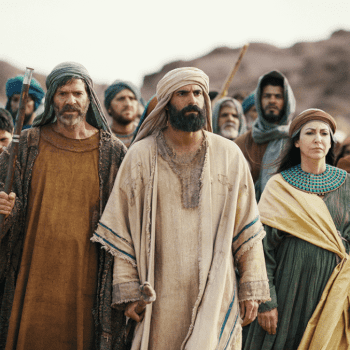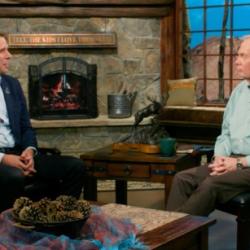It’s January 3, so if you were planning on doing one of those read-through-the-Bible-in-a-year plans this calendar year, you’ve already fallen behind.
And that is exactly as it should be. If you’re not behind, then you won’t have the proper sense of nagging guilt that’s essential to this entire approach to reading the Bible. The guilt is what helps to ensure you regard the project as an unpleasant duty, and a burdensome, obligatory chore. That’s what “daily devotions” and “quiet time” are all about.
The link above takes you to a page listing a variety of these Bible-in-a-year plans. Some of these are more sophisticated than others, but ultimately all such checklist approaches boil down to basic arithmetic. Our Bibles have been conveniently chopped into 31,102 verses, divided by 365 days in a year. So then it’s just a matter of slicing it into little 85.2-verse chunks for daily consumption.
The crudest form of such a plan, then, would be to start by reading Genesis 1:1 through Genesis 4:5 on Day One, then reading Genesis 4:6 through Genesis 7:12 the following day, etc. etc. Alas, such blunt arithmetic interrupts the flow of the text, cutting you off on Day One in the middle of the story of Cain and Abel and abruptly chopping up the story of Noah and the Ark on the following day. So most of these plans try to be slightly more artful about where they draw the lines, allowing longer readings on some days and shorter on others to avoid slicing things up in a way that renders particular stories or pericopes unintelligible.
The more sophisticated plans also try to mix things up a bit by combining readings from several different parts of the Bible in each day’s selections — a shorter slice of Genesis along with a Psalm and perhaps a snippet from one of the New Testament epistles as well.*
However you slice it, though, every such scheme turns out to be a very strange way to approach reading a book. This just isn’t how reading books usually works.
Say you decide, after recommendations from a couple of good friends, that you’re going to read Gillian Flynn’s popular thriller Gone Girl. It seems unlikely that you would take this 422-page novel and decide to set aside a few minutes each morning every day to read 1.15 pages so as to finish reading the book in a one year. That’s not how the book is supposed to be read. It’s not how any book is supposed to be read.
And it’s not how any of the millions of readers who devoured Flynn’s book actually read it. What they did, instead, was set it on their nightstand and settle down to read a chapter or two before turning out the light to go to sleep. Or maybe one more chapter if it’s a really good part. (And then maybe one more.) Or they read it on the train on the way to work. Or while eating lunch. Or sitting on the beach while on vacation. It’s a book, in other words, and people read it the way that people read books, which almost never entails a meticulously planned arithmetical scheme turned into a daily chore and obligation.

This is why we don’t have such schemes constructed for, say, reading Tolkien in a year. That’s just not how books work. Imagine trying to stick with such a plan — Day 58: the first three pages of the arrival at Beorn’s house, the Fall of Isengard, pages 97-103 of the Silmarillion, and chapter six of Sir Gawain and the Green Knight. Ugh. No one has ever read those stories in that way and anyone who tried would get to the end unsure of what they’d just read.
I can sort of imagine such a scheme not being a terrible approach for some very few particular books, like perhaps the Complete Poems of Emily Dickinson. 1,775 poems divided by 365 days would come to about five a day. And since those short, fierce poems are mostly self-contained, such a system wouldn’t detract from the reader’s understanding or appreciation of them.
But most books aren’t like that and most books do not welcome or benefit from such a divide-and-conquer approach.
We’ve convinced ourselves that the Bible is akin to that anthology of Dickinson because we’ve already chopped the thing up into chapters and the bite-sized fragments of those 31,102 verses. All of that gives it the appearance, on the page, of something similar to a collection of short poetry, complete with numbered stanzas.
But that’s not what the Bible is. It’s a book. It’s 66 books. One of those 66 books — the Psalms — is actually very much like the collected Emily. That’s an anthology of 150 discrete, self-contained poems and the reader’s understanding and enjoyment of those poems probably wouldn’t suffer a bit from some structured scheme involving reading one every day in a way and at a time the reader doesn’t usually reserve for reading.**
But most of the books of the Bible aren’t like that and don’t benefit from being read that way. So here’s my novel scheme for reading those books: read them like you read books. Set them on the nightstand for reading before bed. Take them on the train. Take them to the beach. Read them the same way you’d read Gone Girl or The Two Towers.
Reading all 66 books of the (Protestant) Bible in one year is a manageable goal. That sounds like a lot — 66 books in 52 weeks! — but these “books” mostly are not book-length. They were written long before books were a thing, and they tend to be pretty short. One of my favorites, for example, is the book of Jonah, which is only a few pages long. Reading Jonah or, say, Philippians, in one sitting is no trouble at all. “Books” like that are almost too short for one sitting.
But while these books may not be book-length, it’s still best to treat them as books. Read them the way you read books because that’s what they are. If reading books is something you set aside 20 minutes for every morning before you get ready for work, then go ahead and read the books of the Bible that way too. But that’s not how most of us read books, and if we tried reading most books that way it would ruin the experience.
The books of the Bible are just exactly that. You already know how to read books, and how to enjoy doing so. So if you want to read the Bible in a year, you already know how to do that. Don’t let anybody convince you it’s any more complicated than it is.
– – – – – – – – – – – – –
* Skipping around instead of just starting at Genesis and plowing straight through is also an attempt to avoid the Leviticus Problem. Leviticus being the place where good intentions about reading the Bible straight-through always seem to die. And that’s actually generous — since the beginning-to-end approach usually founders even before then, in the post-crossing-of-the-Red-Sea portions of Exodus, where the books of Moses first shift from a collection of stories to a list of laws and regulations.
At the risk of offending or appalling my inerrantist friends and causing them all to, yet again, start shouting 2 Timothy 3:16 at the top of their lungs, allow me to humbly suggest a different approach to getting past the hurdle of the Leviticus Problem: Just skip that stuff. Come back to it later if you’re up for it, after you’ve finished the other 60+ books. Or not.
Imagine you’ve got a friend who’s never seen a Hitchcock movie. Where do you start? Well, I’d start with North by Northwest, and Rear Window, The Birds and maybe Foreign Correspondent and The Lady Vanishes — the fun stuff that’s maybe a little easier and is sure to get ’em hooked. Then, later, eventually, you can tackle Vertigo. And then, even further down the line, if they’re really interested and want to get all completist about it, you can go back and hit all the early silent pictures. Point being you don’t start off with The Pleasure Garden.
** And, yes, the Psalms’ prosaic little companion, Proverbs, can probably also be read that way without distorting one’s understanding or appreciation of it. It’s an almanac — a collection of individual (if often duplicated) sayings, and thus one of the few parts of the Bible that escapes the distorting effect of our insistence on chopping things up into separate “verses.”
The fact that Proverbs has been given 31 chapters has made the chapter-a-day reading of Proverbs irresistible in some evangelical circles. This is especially popular as it’s the rare book of the Bible designed to offer what evangelical readers have been trained to seek in all of the Bible — short, pithy bits of practical advice, stated directly and suitable for cross-stitching.
I think such daily reading of Proverbs is a good way to appreciate that book on its own, but I think appreciating that book on its own is also a huge mistake. There’s a reason that the book of Proverbs is included where it is in our canons — sandwiched in amongst the far darker and more complicated books of Psalms, Ecclesiastes and Job. Those books are meant to be read as a counterweight to the sometimes facile, discounting-friction calculus of the Proverbs. Study Proverbs in isolation and you’re in danger of turning into Bildad, Eliphaz, Zophar or Elihu.















